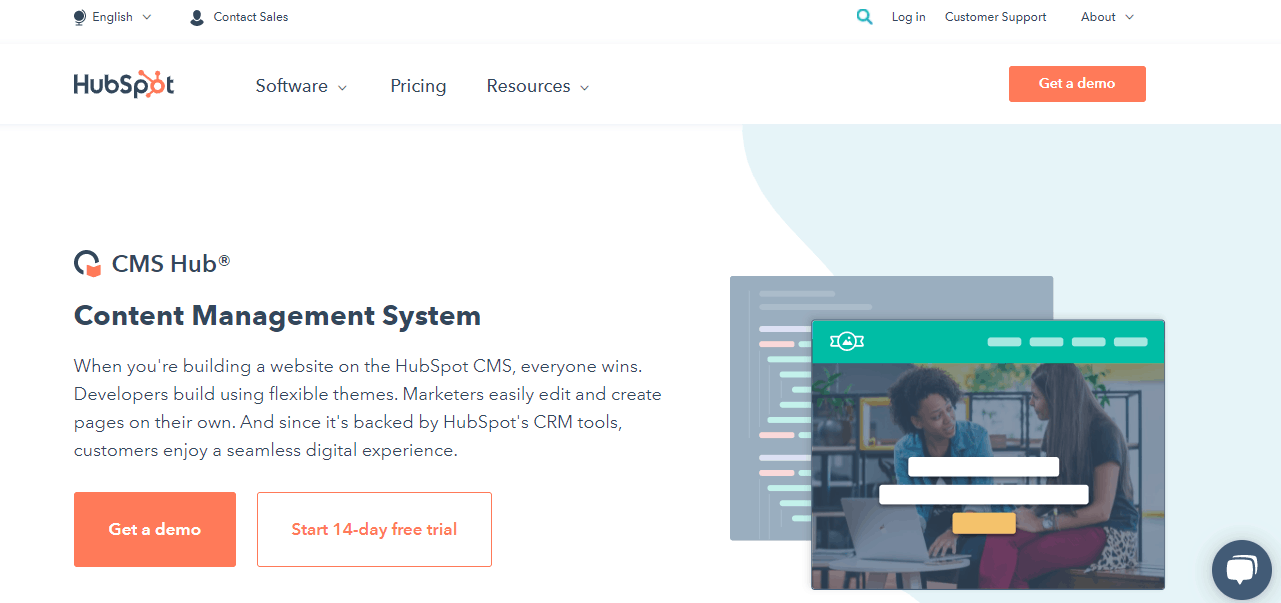
19 Jul What Is a Content Management System?
You might have seen the term “CMS” concerning websites. Perhaps you even know that it stands for “content management system”. But, what is a content management system, and why is it important?
This guide will explore what exactly a CMS is, examine some examples, and also explain the benefits of using one.
Table of Contents
Content Management System
A content management system or CMS is simply a software application that allows you to build and manage a website. With a CMS, there’s no need to know how to code or do any complicated coding to get your website to come to life. All you need to do is use the tools in the content management system to put together your site and its pages.
In addition, you can create, manage and publish your content all from the CMS, which is designed to have a user-friendly interface that pretty much anyone can use. When you choose a small business web design service, you might select one that will create a website using a CMS such as WordPress.
 Moreover, a CMS is excellent to use if you’re working on a website on your own, even if you’re a complete beginner at creating a website. On the other hand, it’s also helpful to have more than one person working on your site, allowing a team to work together using the same tools. Having a team will enable you to control your website when it’s complete instead of relying on people who can code.
Moreover, a CMS is excellent to use if you’re working on a website on your own, even if you’re a complete beginner at creating a website. On the other hand, it’s also helpful to have more than one person working on your site, allowing a team to work together using the same tools. Having a team will enable you to control your website when it’s complete instead of relying on people who can code.
Finally, a CMS makes it much easier to create and maintain a website. Without a CMS, you need to use HTML, CSS, and JavaScript coding to put a website together. It’s time-consuming and complicated, and so is making any further edits. Of course, anyone who has the skills to do this might find it easy.
However, it won’t be something that comes easily to you if you’re not a developer. Fortunately, a CMS makes the whole process of creating and updating a site much more straightforward for anyone who wants to do it.
Examples of Content Management Systems
There are multiple content management systems that you can use to build your site. You have probably heard of some of them, although others are probably more familiar to those who already know a little about web development.
WordPress: WordPress is the most popular CMS option, with an estimated 64 million websites currently using the system. It’s a self-hosted platform, meaning that you need to find hosting for your site and install it. Installing is pretty easy to do on your own, or you can get your web developer to do it for you. Also, it has plenty of themes and plugins that make customizing the design of a site accessible, as well as an intuitive editor for pages and blog posts
CMS Hub: CMS Hub is offered by HubSpot, making it possible to create content for your visitors from your HubSpot CRM. It has tools that allow you to create custom templates, A/B test your content, view analytics for your website performance, and more
 Magento: Magento OpenSource, another self-hosted CMS, is a popular choice for people who want to set up eCommerce stores. It’s a very secure platform with plenty of features, although it takes a little longer to learn than some other CMS platforms
Magento: Magento OpenSource, another self-hosted CMS, is a popular choice for people who want to set up eCommerce stores. It’s a very secure platform with plenty of features, although it takes a little longer to learn than some other CMS platforms
Drupal: Drupal is often used by large corporations and government organizations. It’s very flexible, but it’s also more suited to someone who has some web development experience if you want to make the most of it

Webflow: Webflow is a very visual CMS, allowing you to easily see what your site looks like as you make it. With options for webflow enterprise maintenance, you can ensure your large-scale website remains robust and functional after deployment.
You can begin building a website with one of the many templates or start from scratch. Webflow is also suited to web designers who have at least some knowledge of basic coding
The Benefits of a CMS
 Why should you use a CMS? A content management system offers a variety of benefits to help you build a fantastic website. Many content management systems don’t require any knowledge of coding, which means that just about anyone can use them. Also, you don’t have to rely on website developers or designers to get things done, although you can still turn to them for help.
Why should you use a CMS? A content management system offers a variety of benefits to help you build a fantastic website. Many content management systems don’t require any knowledge of coding, which means that just about anyone can use them. Also, you don’t have to rely on website developers or designers to get things done, although you can still turn to them for help.
Furthermore, a CMS makes it easy for your team to collaborate. Multiple people can use the same system and make edits or add new content. You can control who has permission to do what, and you can enable people from your marketing, IT, or design departments to contribute to your site, improving teamwork and productivity too.
Finally, CMS platforms offer a vast range of features, allowing you to customize your site how you want it. They help you make your site SEO-friendly, and you can integrate various third-party tools to add functionality. Templates or themes make it easy to get started, giving you a readymade site design that you can customize. Once your site is built, it’s easy to make updates or publish new content.
Using a CMS
 A CMS is designed to be easy to use compared to coding from scratch. It’s effortless to get started and to continue working on your site. You have an admin panel or dashboard that you can use to switch between different tasks.
A CMS is designed to be easy to use compared to coding from scratch. It’s effortless to get started and to continue working on your site. You have an admin panel or dashboard that you can use to switch between different tasks.
When you use the editor to create a page or a blog post, you can easily add text, links, images, and other media. In addition, you can make changes like the size and color of the text or the page’s layout with the click of a button. Plus, you can save your work as a draft as you go so that you don’t lose anything and revert to earlier versions when you need to. When you’re ready for your content to be live, you can publish it with the click of a button.
Therefore, a content management system is a must if you want to control your website design without any coding.



No Comments